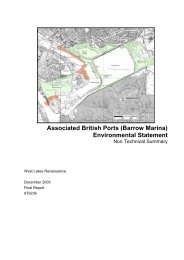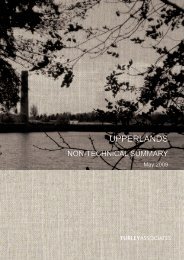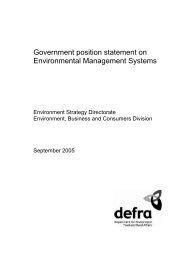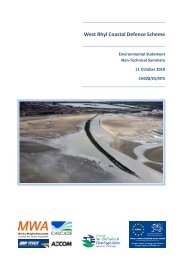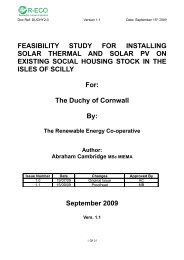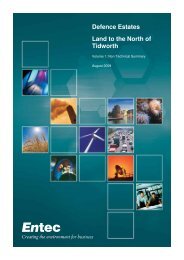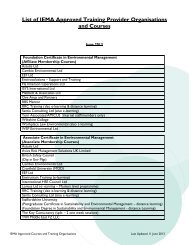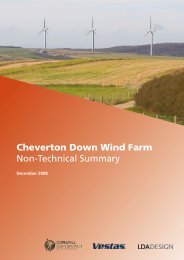Environment Law Bulletin - Institute of Environmental Management ...
Environment Law Bulletin - Institute of Environmental Management ...
Environment Law Bulletin - Institute of Environmental Management ...
Create successful ePaper yourself
Turn your PDF publications into a flip-book with our unique Google optimized e-Paper software.
Health and safety – finesYorkshire Sheeting & Insulation Services Ltd(the defendant) was sub-contracted to carryout ro<strong>of</strong>ing works at commercial premises.In turn, the company engaged a number <strong>of</strong>self-employed workers, including one manwho fell through a ro<strong>of</strong> light and wasfatally injured. Yorkshire Sheeting &Insulation and the main contractor (the codefendant)pleaded guilty to failing toensure the safety <strong>of</strong> persons not in theirdirect employment, an <strong>of</strong>fence undersection 3(1) <strong>of</strong> the Health and Safety atWork etc. Act 1974. In his sentencingremarks, the judge commented that thevictim was an employee <strong>of</strong> the defendantand that the company, as employer, boreprimary responsibility for his safety: had itbeen a civil case, the relative moral culpabilitywould have been apportioned as 90%to the defendant and 10% to the codefendant.A fine <strong>of</strong> £100,000 wasimposed on Yorkshire Sheeting &Insulation, with £8,950 costs, whilst the codefendantwas fined £10,000 andsignificantly lower costs. Yorkshire Sheeting& Insulation appealed against this sentence,arguing that the judge’s approach had beenwrong: the victim was not actually anemployee, some factual errors had beenmade and a precise percentage approach torelative culpability should not have beenadopted. The appeal was successful. TheCourt <strong>of</strong> Appeal held that the judge haderred in his sentencing by making factualerrors and that his approach masked thetrue nature <strong>of</strong> the sentencing exercise. Toomuch emphasis had been placed on theapportionment <strong>of</strong> overall liability betweenthe two parties and not enough onassessing the defendant’s degree <strong>of</strong> culpabilityand criminality in respect <strong>of</strong> the<strong>of</strong>fence and the failure to take steps toensure so far as is reasonable practicablethe safety <strong>of</strong> the ro<strong>of</strong> workers (followingthe guidelines in R v F Howe & Son(Engineers Ltd) [1999] 2 All ER 249). Settinga tariff for health and safety cases was notpossible as each case must be decided onits own merits. In this case, a substantialfine was required but the £100,000 fineimposed was excessive. Taking into accountthe defendant’s culpability and mitigation,an appropriate fine was in the region <strong>of</strong>£60,000, an amount that would bereduced to reflect the costs order that wasdetermined in relation to the proportion <strong>of</strong>the original fines. Yorkshire Sheeting &Insulation’s fine was quashed and a newfine <strong>of</strong> £55,000 imposed.(R v Yorkshire Sheeting & Insulation Ltd, [2003] EWCACrim 458, 26 February 2003)HedgerowsUnder The Hedgerows Regulations 1997,prior notice <strong>of</strong> the removal <strong>of</strong> certain types“The Court <strong>of</strong> Appeal held that the judge had erredin his sentencing by making factual errors and thathis approach masked the true nature <strong>of</strong> thesentencing exercise.”<strong>of</strong> hedgerows must be given to a localauthority, subject to specific exemptions,including the proper management <strong>of</strong> ahedgerow. A decision must be reached bythe local authority within a prescribedperiod on whether to allow the removal orto issue a hedgerow retention notice. It isan <strong>of</strong>fence to fail to serve a hedgerowremoval notice. In this case, Mr Lloyd notifiedConwy County Borough Council thathe proposed to remove 100 metres <strong>of</strong>hedgerow but before the period prescribedfor the Council to reach its decision hadelapsed, the hedgerow was removed. In thesubsequent prosecution, Mr Lloyd arguedthat the work carried out had not in factrequired notification because the removalwas necessary ‘for the proper management<strong>of</strong> the hedgerow’ (regulation 6(1)(j)).Evidence was accepted by the justices thatthe hedgerow was worthless anddangerous and that its removal was necessaryfor proper management. Mr Lloyd wasacquitted and the Council appealed,arguing that allowing the complete removal<strong>of</strong> a hedgerow to come within permittedworks under regulation 6(1)(j) wouldprovide a mechanism for the Regulations tobe circumvented. The High Court wasrequired, inter alia, to decide whether the49<strong>Environment</strong> <strong>Law</strong> <strong>Bulletin</strong>April 2003



